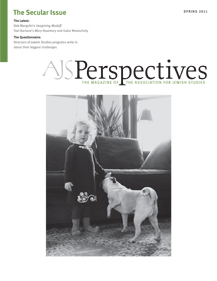Dear Colleagues,
Anyone who is a member of a large, disciplinary society has undoubtedly seen reports over the past few years regarding the decline in job opportunities across the liberal arts, and the simultaneous rise in the proportion of contingent faculty making up university departments. Jewish Studies is of course not immune to these developments, but a preliminary review of AJS's position listings over the past several years suggests that job opportunities have held up relatively well, especially when compared to other fields' double-digit annual drops in job postings. Certainly, job boards do not represent all employment opportunities in a given field, and a job advertisement does not necessarily mean an appointment was ultimately made. But, job boards are a good indicator of what sort and how many job options a scholar may seek, and learned societies use them to track overall developments in their field.
An initial survey of the AJS position listings since the mid-2000s conducted by Karen Terry, AJS program and membership coordinator, bears some interesting insights. For instance, from 2006 to 2010, the total number of positions advertised on the AJS website, which includes academic and non-academic positions, held relatively steady (89 in 2006; a peak of 95 positions in 2007; and 90 in 2010). Among the academic positions advertised from 2006 to 2010, anywhere from 25 to 28 were named appointments or fellowships. From 2006 to 2008, the ratio of permanent to temporary positions advertised was close to 50:50, with some minor variations from year to year. A more significant gap had emerged by 2010, when institutions advertised 51 temporary academic positions and 32 permanent positions. It should be noted, though, that 10 of the 51 temporary positions advertised in 2010 were fellowships in Israel for American scholars, sponsored by the US-Israel Educational Foundation.
Comparing the content of advertisements posted in 2006, 2008, and 2010, we get a snapshot of subfields of Jewish Studies over a five-year span. In 2006, the largest number of permanent (i.e., tenure-track or tenured) positions advertised were with the field of specialization open (9), followed by: Rabbinics/antiquity (7); Hebrew literature and language, Jewish thought/philosophy, and history (3 each); Yiddish literature and language, Jewish education, Holocaust Studies, and Bible (2 each); and the social sciences, gender studies, and Sephardic Studies (1 each). Of the permanent positions in 2006, 27 were at the assistantprofessor/tenure-track level, 9 at the associate- or full-professor level, and 4 were for center/institute directors with part-time teaching. Also in 2006, 13 temporary (i.e. adjunct, lecturer, visiting) positions were advertised with the field of specialization open, followed by: 9 temporary positions in Hebrew; 8 in history; 2 each in Israel Studies, literature, and modern Jewish thought; and 1 each in gender studies, Bible, Yiddish, and Rabbinics.
In 2008, the largest number of permanent (i.e., tenure-track or tenured) positions advertised was in history (19). This was followed by: field of specialization open (5); Israel Studies (4); Bible (3); Hebrew (3); Holocaust Studies (2); and Jewish education, literature, and Sephardi/Mizrahi Studies (1 each). Of the permanent positions in 2008, 30 were at the assistant-professor/tenure-track level, and 10 were at the associate- or full-professor level. Also in 2008, 12 temporary (i.e. adjunct, lecturer, visiting) positions were advertised with the field of specialization open, as well as another 11 positions in Hebrew. Other temporary positions were in history (6); antisemitism, comparative/ interfaith relations, Bible, and Rabbinics (2 each); and Holocaust Studies, gender studies, Israel Studies, sociology, and modern Jewish thought (1 each).
By 2010, the largest number of permanent (i.e. tenure-track or tenured) positions advertised were in history (10), followed by: field of specialization open (7), Bible (5), and Israel Studies (5). One position was advertised in each of the following fields: modern Jewish thought the arts, education, interfaith/multicultural studies, and Holocaust Studies. Of the permanent positions, 25 were at the assistant-professor/ tenure-track level, and 7 at the associate- or full-professor level. Twenty-nine temporary (i.e. adjunct, lecturer, visiting) positions were advertised with the field of specialization open (including 10 postdoctoral fellowships for American scholars to teach in Israel), followed by 9 temporary positions in Hebrew, 8 in history, and 1 each in comparative/interfaith relations, gender studies, Israel Studies, Bible, and education.
Again, these are preliminary figures, and the AJS will continue to analyze the data and post more formal findings on its website in the coming months. We know such information is important to members and hope to expand our work collecting data on all aspects of the field.
Rona Sheramy
Association for Jewish Studies

